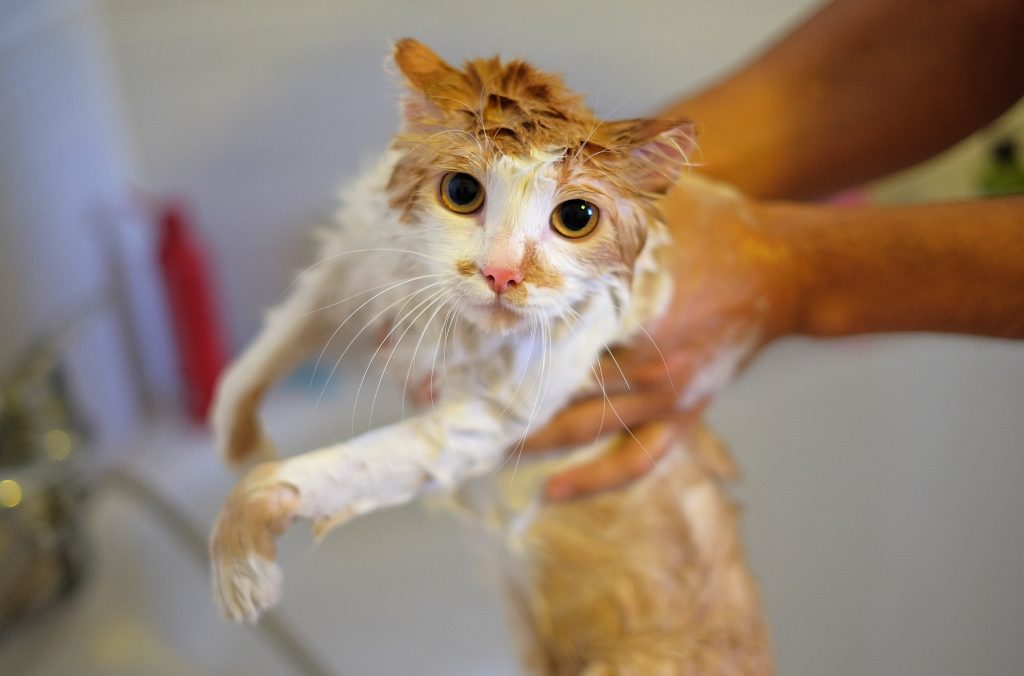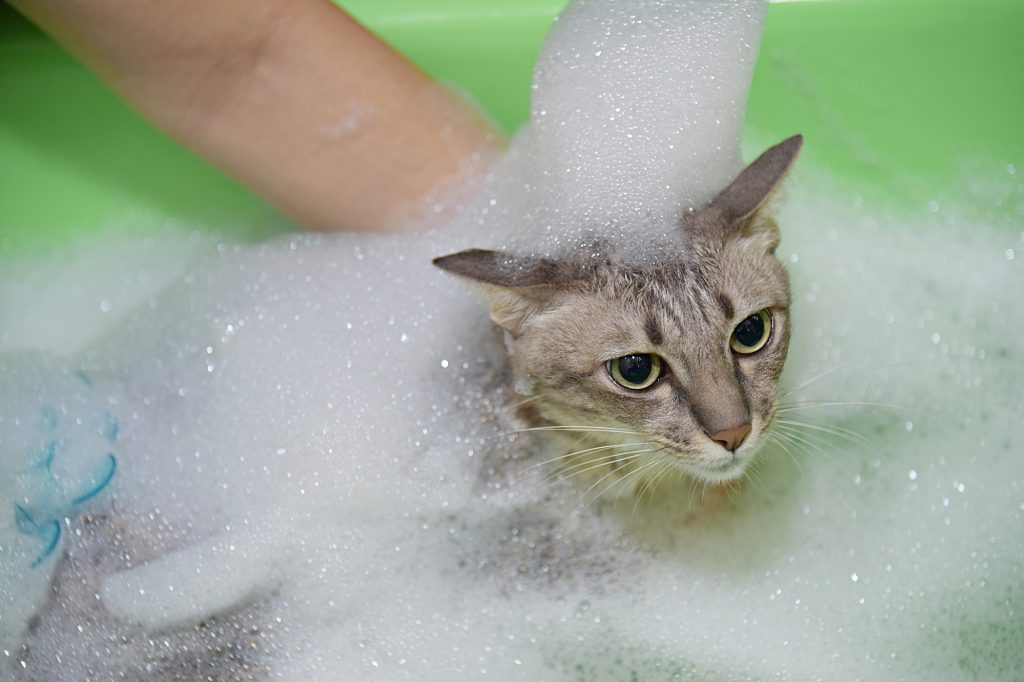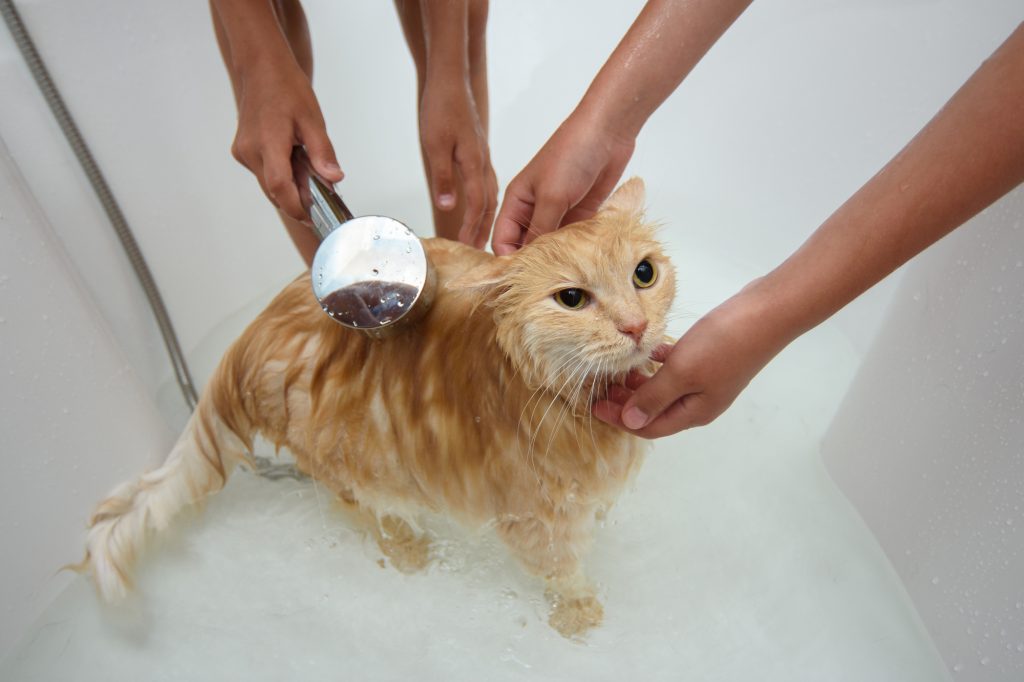Table of Contents
When bathing your cat, it’s crucial to maintain a sense of calm to keep your cat calm. Before you wash a cat, trim its nails to prevent scratches. Use a calming diffuser in the bathroom to create a safe and secure environment, and ensure the water temperature is just right to help your cat tolerate baths. A rubber mat can provide secure footing and prevent slipping, making the experience less stressful for both of you.
Start by gently wetting your cat’s coat, avoiding the face and ears, and use cat-friendly shampoo. Apply the soap gently, rinse thoroughly, and allow your cat to air dry in a warm space. Remember, some health issues may arise from improper bathing, so it’s key to follow these tips and proceed with care when bathing a cat.
Do Cats Actually Need Baths?
While cats are self-cleaning animals, there are occasions where routine bathing becomes necessary. Your cat’s rough tongue is covered with tiny, curved barbs that act as a natural comb when they lap their fur. This action not only cleans but also spreads healthy natural oils throughout their coat. However, the frequency of bathing your cat may need to increase if they cannot clean themselves due to age, weight, or health issues.
Cats typically use licking and biting to rid their fur of dirt and debris. However, if your cat gets into something sticky or toxic, or develops a skin condition that requires medicated shampoo, you’ll need to step in. In such cases, remember that bathing should complement their natural grooming habits, not replace them.

Determining the Ideal Bathing Frequency for Your Cat
Understanding the ideal bathing frequency for your cat involves observing their lifestyle and health. Indoor cats may require less frequent baths than outdoor cats who are more prone to getting dirty. Also, consider if your cat has long hair, as these breeds often need more regular grooming to prevent mats and tangles.
There are several tips to help determine the perfect schedule. Monitor your cat’s behavior and coat condition, and consult with your veterinarian for a personalized recommendation. Always prioritize your cat’s comfort and health when deciding on how often to bathe them.
Preparing for the Inevitable Splash
When you wash a cat, prepare for water and suds to go everywhere. Place a rubber mat in the tub to prevent slipping, which can make the experience less frightening for your feline friend.
Gather the Necessary Supplies
Having all your supplies on hand before starting the bath is essential. This includes cat-friendly shampoo, several soft towels, and a cup or handheld sprayer for rinsing. If you’re using a blow dryer, make sure it’s set to a low heat setting and is ready to go. Having treats nearby can also help make the experience more positive for your cat.
Position everything within arm’s reach to avoid leaving your cat unattended during the bath. This will help you wash your cat efficiently and reduce stress for both of you. After the bath, wrap your cat gently in a dry towel to remove excess water and then let them air dry in a warm, draft-free room.
Set up the Bathing Area
Before you start, ensure the room is warm and free from drafts. Place a non-slip mat in the sink or tub to keep your cat secure. Fill the basin with a few inches of lukewarm water—testing it with your elbow to ensure it’s not too hot or too cold. Have a handheld showerhead or a cup ready for rinsing, which can be less intimidating than running water.
Keep several dry towels on hand to cushion the space and for drying off your cat. If you plan to use a blow dryer, plug it in and place it within reach, but away from water to ensure safety. Double-check that you have everything you need before you bring your cat into the space to minimize any potential stress.

Techniques for Bathing a Cat That Hates Water
For cats that dislike water, it’s important to be gentle and patient. Consider visiting a veterinary clinic to discuss cat health and best practices for how to wash a cat that’s apprehensive about water.
• Prepare in Advance
To successfully bathe a cat that hates water, start by preparing all necessary items. This includes having a blow dryer set on a cool setting, a handheld showerhead for a gentle rinse, and making sure the room is warm to prevent chills. Place a non-slip mat in the bathtub to provide secure footing and help reduce anxiety.
• Choose the Right Cat-Friendly Shampoo
Choosing the right shampoo is critical for maintaining your cat’s coat and skin health. Consult your veterinarian to find a product that’s suitable for your cat’s fur. Avoid using human shampoos as they can be harsh on your cat’s skin and disrupt the natural pH balance of their coat.
• Trim Nails Before Bathing
Trimming your cat’s nails prior to bathing can help minimize the risk of scratches. Use a pair of nail clippers designed for cats, and snip just the tips to avoid cutting the quick. Your feline friend will be less likely to cause injury if they become anxious during the bath.
• Start With a Dry Run
Before introducing water, get your cat gently accustomed to the bathing area. Let them explore the space and give them plenty of affection. Stroke your cat to provide reassurance and help them associate the space with positive experiences.
• Plan a Short Cat Bath
When the bath is inevitable, use cat shampoo and conditioner that are suitable for cats to avoid irritating their coat and skin. Prepare a bath with soapy water, but keep it brief to minimize stress. If you’re giving a cat or kitten a bath, be prepared for them to scratch and claw. It’s crucial to have everything ready beforehand to enable your cat to tolerate a bath with the least amount of fuss.
• Prepare Your Cat’s Post-Bath Experience
After bathing your cat, wrap them in a warm towel immediately to prevent chills. Provide a quiet space for them to finish drying off where they can feel secure and relaxed. A treat or their favorite toy can also help them associate bath time with positive outcomes.
• Consider Professional Grooming
If bathing your cat at home is too challenging, consider employing the services of a professional groomer. Groomers are experienced in handling cats and can wash a cat efficiently, minimizing stress for your pet.
When to Seek Professional Help
Seek professional help if your cat has a strong aversion to water or if you’re unable to bathe them safely at home. A professional can provide an actual bath in a controlled environment, often using toys in the water to distract and calm your cat. They can also work with you to help your cat become more comfortable with water over time.
If your cat’s stress levels don’t improve or you’re concerned about their reaction to running water, a professional can assess the situation and offer guidance. They can also detect any underlying issues that may be contributing to your cat’s fear of water and suggest appropriate steps to take.

Frequently Asked Questions
1. Are baths stressful for cats?
Yes, baths can be quite stressful for cats. They are creatures of habit and prefer their grooming rituals. Introducing water can cause anxiety and fear. To reduce stress, use a rubber mat in the sink or tub to prevent slipping, and always consult your veterinarian regarding the frequency of bathing your cat, as each cat’s needs may differ.
2. Do cats like cold baths?
Cats generally do not appreciate cold baths. They prefer warm, not hot, water, which feels more natural and soothing to them. A comfortable water temperature mimics the warmth they would experience from the sun or a cozy spot in the house, making the bathing experience less jarring.
3. Can I use Dove soap on my cat?
No, it’s not recommended to use Dove soap or any human soap on cats. These products can strip away natural oils from their coat and skin, leading to dryness and irritation. Instead, choose a cat-friendly shampoo specifically formulated for feline skin and coat. In cases where cats have gotten into substances like motor oil, your veterinarian might also recommend medicated baths for treating other health issues. However, long-haired cats and hairless breeds often benefit from regular baths to manage oily residue.
4. Why do cats hate water so much?
Many cats hate water due to their evolutionary background, which did not require them to swim or deal with large bodies of water. The sensation of being wet can also be uncomfortable for them, as it weighs down their fur and can cause them to feel cold. To help cats tolerate baths, ensure that the sink or tub is comfortable and the clean water is at a pleasant temperature.
Bath Time Wrap-Up
Bathing your feline companion may have its challenges, especially if they’re not fond of water. However, with patience and the right approach, it can become a manageable task. Remember to gently comb out any knots or tangles after the bath, particularly if you have a long-furred breed, to keep their coat smooth and prevent mats from forming. It’s also a good time to check for fleas and ticks as they’re more visible on wet fur.
If you ever feel overwhelmed or notice your cat is excessively stressed during bath time, don’t hesitate to seek assistance from a professional groomer or your local animal hospital. They can provide services and advice to ensure your pet health remains a top priority. With a little practice and a lot of love, bath time can be another way to strengthen the bond with your furry friend.

Hi, I’m Zoey, a devoted mom to two charming Siamese cats. My passion lies in assisting fellow pet owners in providing optimal care for their cats. On CatsEuphoria, I share practical tips and relatable stories, inviting you to join me in appreciating the authentic bond between humans and our beloved feline companions.




